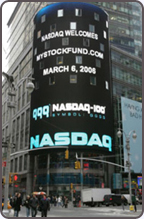|
The Growing World of ETFs
By Bob Carlson
Exchange-traded funds (ETFs) are the fastest-growing but most misunderstood investment vehicle of the last few years. ETFs have been around only since 1993, and didn’t start to take off until the late 1990s. While often promoted as alternatives to mutual funds, ETFs also fit nicely into the strategy of buy-and-hold stock investors.
An ETF has some similarities to a mutual fund. The investor buys shares in the ETF, which owns a number of stocks. Unlike a mutual fund, an ETF is purchased on an exchange just like a stock. Beyond that, ETFs differ in significant ways from mutual funds. Those differences make ETFs attractive to stock investors.
ETFs are designed to track indexes. There are ETFs that track the major stock indexes: the S&P; 500 (SPY), Dow Jones Industrial Average (DIA), Russell 3000, and the NASDAQ (QQQQ). There also are ETFs that track small stock indexes. With one purchase, an investor gets instant diversification by purchasing a share of an entire stock market index with one share of an ETF. ETFs also slice and dice the indexes in many different ways. There are ETFs that buy only the growth stocks or only the value stocks in the major indexes. Other ETFs purchase only the stocks in an industry sector, such as technology, energy, basic materials, and consumer durables.
Through ETFs an investor can easily purchase international stocks. Some ETFs emulate a worldwide stock index. Others track all the stock indexes in a region, such as Europe, Asia, or Latin America. Alternatively, an emerging markets index can be purchased with an ETF. An investor also can use ETFs to purchase the indexes of individual foreign countries. Someone who wants to invest in Japan and Brazil but none of the other international markets can do so by purchasing the appropriate ETFs.
ETFs also go beyond stocks. There are ETFs specializing in real estate stocks, bonds, and gold. Other types of ETFs are in the planning stage. The variety and flexibility of ETFs offers opportunities to a stock investor. For instance, an investor who wants a broad-based stock portfolio does not have to select a portfolio of individual stocks. Instead, the investor can purchase one of the broad-based ETFs. The most popular ETF, in fact, is the S&P; 500 SPDR, which tracks the S&P; 500. Likewise, an investor who favors small stocks need only purchase one of the small stock indexes, such as the Russell 2000 ETF (IWM).
An investor might favor one or more particular industries (for a list of available ETFs, click here). Suppose an investor believes there is opportunity in the energy sector and wants that sector over-weighted in his portfolio. There is no need to research energy companies and decide which companies offer the best opportunities. There also is no need to buy a portfolio full of individual energy stocks to get diversification. Instead, purchasing one or more shares of an energy sector ETF accomplishes the investor’s goals.
Using an ETF in this manner, especially through a fractional share-purchasing program, makes it easy to maintain the desired weight of an industry or sector in the portfolio. Single shares or fractional shares of the ETF can be purchased or sold as needed to keep the portfolio balanced.
ETFs also overcome many of the obstacles to purchasing international stocks. The investor can purchase one share of an ETF and own a worldwide index, a regional index, or a country index. With ETFs, the investor is not restricted to companies that offer American Depository Receipts (ADRs) that trade on the American exchanges. Almost all the publicly traded stocks in the world can be owned through ETFs. There is no need to deal with foreign brokers or to invest through a major broker that has high minimum account requirements and that charges high commissions.
ETFs can be used to fill holes in a stock investor’s portfolio. For example, it is easy to buy individual stocks, but a small investor has difficulty building a diversified portfolio of bonds. An easy, efficient way to add bonds to a portfolio is to buy one of the bond ETFs. ETFs also are available for investors who want to add gold and real estate stocks to their portfolios. By using ETFs, a fractional share investor can select individual stocks but does not have to settle for investing only in equities. It becomes possible to construct a diversified portfolio using ETFs.
An investor might have a handful of favorite stocks he wants to own, but those stocks do not make a diversified portfolio. With ETFs the investor can buys shares of the stocks he knows and likes, and diversification is achieved by purchasing shares of a broad-based ETF to fill out the portfolio.
ETFs have very low expense ratios. The SPDR 500, which tracks the S&P; 500 index (SPY), has an expense ratio of 0.11%. That is significantly lower than the expense ratio on most mutual funds, even the index funds. Some fund companies recently lowered their expense ratios on index funds to 0.10%, primarily to prevent assets from migrating to ETFs.
ETFs also tend to be tax efficient, even more tax efficient than many index mutual funds. The tax law allows ETFs to exchange securities tax-free. An ETF generally has to make taxable transactions only when the components of the index it tracks are changed. Unlike even index mutual funds, most ETFs have made few taxable distributions over the years.
Yet, there are some potential disadvantages to ETFs. Almost all ETFs are index funds. Each tracks a selected index. An investor will not get the benefit of any active management from an ETF, except his own decisions to buy and sell the ETFs. Also, since they trade like stocks, ETFs do have regular trading costs. There is no ETF equivalent of a no-load mutual fund.
The trading price of the ETF can differ from the value of the stocks it owns. The premium or discount is almost nonexistent with the more popular, heavily traded ETFs, but it occasionally is meaningful for the lightly-traded ETFs, such as some of the single country ETFs. For a buy-and-hold investor the spread will have a very small long-term effect. For investors who trade or make frequent purchases, the difference can mount for the lightly traded ETFs.
An ETF also can have tracking error relative to its index, which means its returns will differ from the index’s published returns. This occurs for several reasons. The ETF cannot reinvest dividends as quickly as the published index can, reducing gains a bit. Of course, there are fees and expenses to deduct and costs incurred when the index changes or the fund needs to be rebalanced. A number of ETFs cannot replicate exactly the indexes they track. An index might have too many securities, or some of them might be difficult to trade. Such ETFs have to buy a sample of securities that the managers believe will get the same or similar performance. All of these factors cause some differences between the returns of ETFs and the indexes they follow.
Not all ETFs are as tax-friendly as others. Single-country ETFs lose some tax benefits if more than 25% of the fund is in the securities of a single issuer. Breeching that barrier is not unusual for a single-country ETF. To avoid the breech, the ETF must sell some shares and distribute taxable gains. Also, some dividends will not qualify for the 15% tax rate, because the ETF did not own the shares for the minimum holding period.
Keep in mind that a sector or single-country ETF might be dominated by just a few stocks. The Dow Jones U.S. Energy Index (IYE) is 40% invested in ExxonMobil (XOM) and Chevron (CVX). The investor will not get as much diversification as they might think. Further,despite the large number of ETFs, you cannot (yet) build a full portfolio solely with ETFs. You will not find ETFs that invest in high yield bonds, municipal bonds, international bonds, and commodities (other than gold and real estate).
One difficulty for some investors is deciding which ETF to purchase. For some investment options there is only one ETF available. But for others there are several ETFs from which to choose, each tracking a different index. For example, an investor who wants to buy a diversified portfolio of small company stocks must choose between ETFs tracking the Russell 2000, S&P; 600, and Dow Jones US Small Cap, plus growth and value variations of those indexes. Though all the indexes are of small company stocks, they do not hold all of the same stocks and the stocks they hold in common often are held in different amounts. Over time, the indexes will have different rates of return and different levels of volatility.
For the long-term investor, ETFs offer an easy, inexpensive way to buy and hold a diversified portfolio. ETFs let the investor build a more diversified portfolio than is possible with individual stock purchases. The ETFs also offer an easy way to customize a portfolio; sectors and countries can be over-weighted or under-weighted as the investor desires.
There are several sources of details about ETFs. ETFConnect.com offers quite a bit of free information on ETFs. The issuers of ETFs offer details about "their funds at www.ishares.com, www.rydexfunds.com, , www.streettracks.com, and www.vanguard.com.
Bob Carlson is editor of Retirement Watch, a monthly newsletter covering all the financial aspects of retirement and retirement planning (www.RetirementWatch.com; 800-552-1152). He also is author of The New Rules of Retirement (Wiley, 2004).
|







